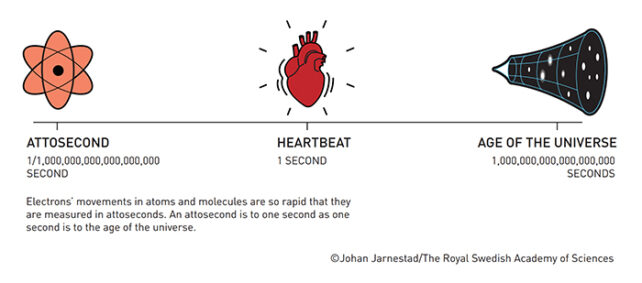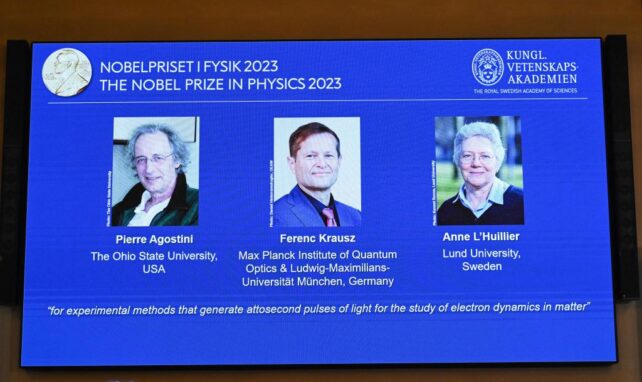The Nobel Physics Prize was awarded on Tuesday to 3 scientists for their work on attoseconds, that are nearly unimaginably brief durations of time.
Their work utilizing lasers offers scientists a device to look at and probably even manipulate electrons, which may spur breakthroughs in fields comparable to electronics and chemistry, specialists advised AFP.
How briskly are attoseconds?
Attoseconds are a billionth of a billionth of a second.
To offer a bit perspective, there are round as many attoseconds in a single second as there have been seconds within the 13.8-billion 12 months historical past of the universe.
Hans Jakob Woerner, a researcher on the Swiss college ETH Zurich, advised AFP that attoseconds are “the shortest timescales we are able to measure immediately”.

Why do we want such pace?
Having the ability to function on this timescale is vital as a result of these are the speeds at which electrons – key elements of an atom – function.
For instance, it takes electrons 150 attoseconds to go across the nucleus of a hydrogen atom.
This implies the examine of attoseconds has given scientists entry to a basic course of that was beforehand out of attain.
All electronics are mediated by the movement of electrons – and the present “pace restrict” is nanoseconds, Woerner mentioned.
If microprocessors had been switched to attoseconds, it could possibly be doable to “course of data a billion instances quicker,” he added.
frameborder=”0″ permit=”accelerometer; autoplay; clipboard-write; encrypted-media; gyroscope; picture-in-picture; web-share” allowfullscreen>
How do you measure them?
Franco-Swede physicist Anne L’Huillier, one of many three new Nobel laureates, was the primary to find a device to pry open the world of attoseconds.
It includes utilizing high-powered lasers to supply pulses of sunshine for extremely brief durations.
Franck Lepine, a researcher at France’s Institute of Gentle and Matter who has labored with L’Huillier, advised AFP it was like “cinema created for electrons”.
He in contrast it to the work of pioneering French filmmakers the Lumiere brothers, “who minimize up a scene by taking successive images”.
John Tisch, a laser physics professor at Imperial School London, mentioned that it was “like an extremely quick, pulse-of-light machine that we are able to then shine on supplies to get details about their response on that timescale”.
How low can we go?
All three of Tuesday’s laureates at one level held the document for shortest pulse of sunshine.
In 2001, French scientist Pierre Agostini’s group managed to flash a pulse that lasted simply 250 attoseconds.
L’Huillier’s group beat that with 170 attoseconds in 2003.
In 2008, Hungarian-Austrian physicist Ferenc Krausz greater than halved that quantity with an 80-attosecond pulse.
The present holder of the Guinness World Document for “shortest pulse of sunshine” is Woerner’s group, with a time of 43 attoseconds.
The time may go as little as a number of attoseconds utilizing present expertise, Woerner estimated. However he added that this might be pushing it.

What may the long run maintain?
Expertise benefiting from attoseconds has largely but to enter the mainstream, however the future seems to be brilliant, the specialists mentioned.
Thus far, scientists have principally solely been in a position to make use of attoseconds to look at electrons.
”However what’s mainly untouched but – or is simply actually starting to be doable – is to manage” the electrons, to control their movement, Woerner mentioned.
This might result in far quicker electronics in addition to probably spark a revolution in chemistry.
”We’d not be restricted to what molecules naturally do,” however as an alternative may “tailor them in keeping with want,” Woerner mentioned.
So-called “attochemistry” may result in extra environment friendly photo voltaic cells, and even the usage of gentle power to supply clear fuels, he added.







